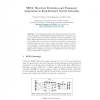Free Online Productivity Tools
i2Speak
i2Symbol
i2OCR
iTex2Img
iWeb2Print
iWeb2Shot
i2Type
iPdf2Split
iPdf2Merge
i2Bopomofo
i2Arabic
i2Style
i2Image
i2PDF
iLatex2Rtf
Sci2ools
GECCO
2003
Springer
2003
Springer
SEPA: Structure Evolution and Parameter Adaptation in Feed-Forward Neural Networks
Abstract. In developing algorithms that dynamically changes the structure and weights of ANN (Artificial Neural Networks), there must be a proper balance between network complexity and its generalization capability. SEPA addresses these issues using an encoding scheme where network weights and connections are encoded in matrices of real numbers. Network parameters are locally encoded and locally adapted with fitness evaluation consisting mainly of fast feed-forward operations. Experimental results in some well-known classification problems demonstrate SEPA’s high consistency performance in classification, fast convergence, and good optimality of structure. 1 SEPA Strategy Until now, ANN architecture design remains to be one of the most important areas of research due to the lack of general criteria in finding an optimal network topology for a particular class of problems. To address this issue, SEPA uses a GA-based model of ANN where weight adaptation is not gradient-based but s...
| Added | 06 Jul 2010 |
| Updated | 06 Jul 2010 |
| Type | Conference |
| Year | 2003 |
| Where | GECCO |
| Authors | Paulito P. Palmes, Taichi Hayasaka, Shiro Usui |
Comments (0)

